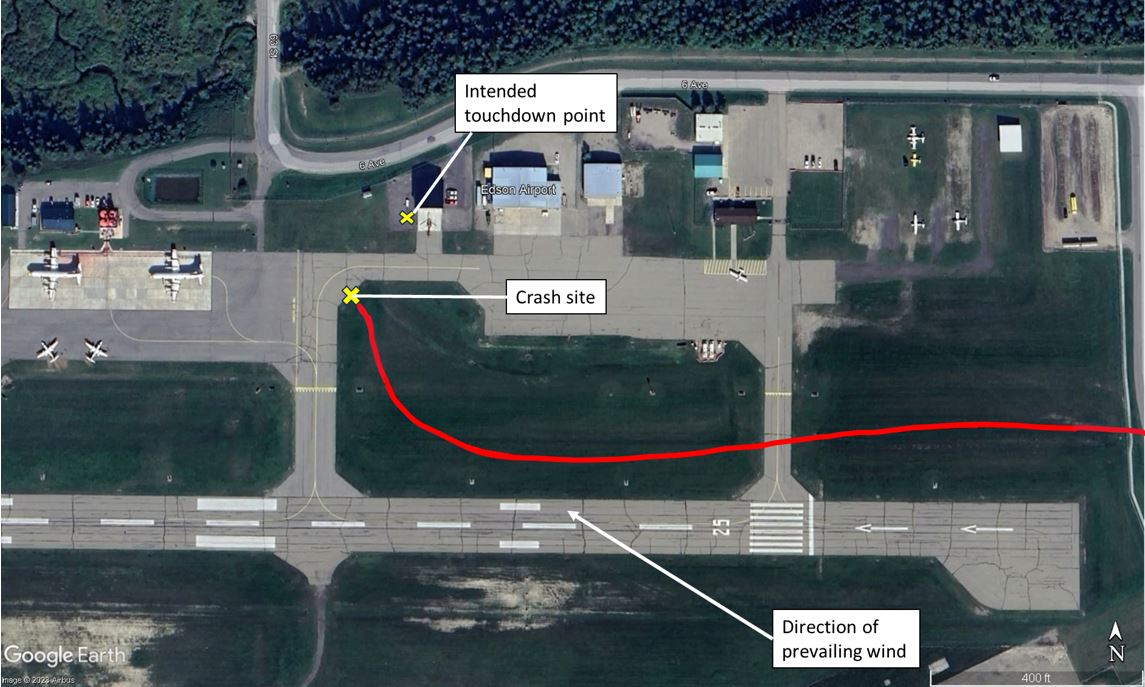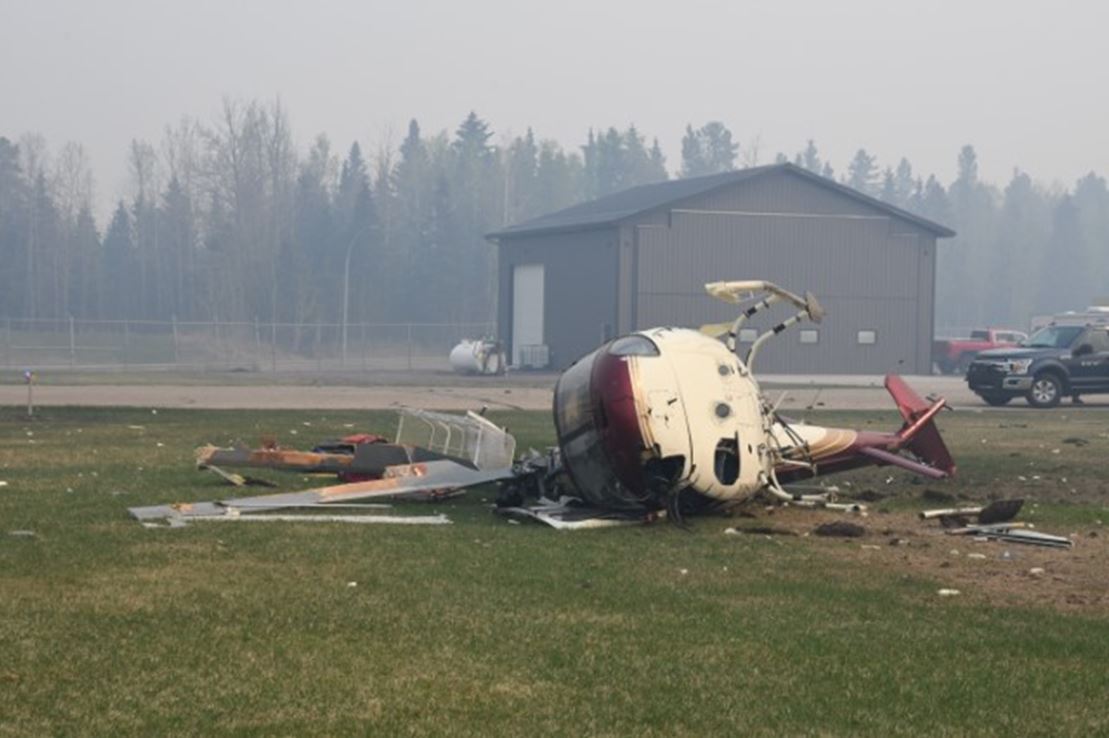Hard landing
Range Helicopters Inc.
Airbus Helicopters AS350 B2 (helicopter), C-FAVX
Edson Airport (CYET), Alberta
The Transportation Safety Board of Canada (TSB) investigated this occurrence for the purpose of advancing transportation safety. It is not the function of the Board to assign fault or determine civil or criminal liability. This report is not created for use in the context of legal, disciplinary or other proceedings. See Ownership and use of content. Masculine pronouns and position titles may be used to signify all genders to comply with the Canadian Transportation Accident Investigation and Safety Board Act (S.C. 1989, c. 3).
History of the flight
On 04 May 2023, the Range Helicopters Inc. (Range Helicopters) Airbus Helicopters AS350 B2 helicopter (registration C-FAVX, serial number 4242) was conducting a return flight to Edson Airport (CYET), Alberta, from a forest firefighting staging area located approximately 49 nautical miles (NM) to the east. When the helicopter was 5 NM east of CYET, a flight of 4 Canadair CL-215T aircraft was approaching the airport from the west and intending to land on Runway 07, which was active at the time. It was reported that the wind was strong and gusting from the east-southeast. The occurrence pilot’s usual approach to the Range Helicopters hangar at CYET involved passing to the south of the town of Edson, Alberta, and then approaching the airport from the west. Upon hearing the intentions of the flight of CL-215T aircraft, the pilot, not wanting to delay the group’s arrival, decided to approach the airport downwind and to the north of Runway 07, between the runway and the taxiway, with the intent of conducting a tight right turn to align the helicopter into the wind (Figure 1).
As the helicopter approached between Runway 07 and the grassy area between taxiways A and B, the pilot began to slow down, eventually reaching a groundspeed of 30 knots.Footnote 1 He noticed a pair of air tankers at the fire base ahead and to his right, and, not wanting to overfly them, he slowed down even more. The helicopter was in a descent at a rate between 300 and 500 fpm with a tailwind of 27 to 36 knots. Just before entering the right turn toward the hangar, the helicopter began an uncontrolled descent from between 50 and 30 feet above ground level (AGL). The pilot applied collective to reduce the rate of descent; however, the rate of descent increased. This scenario is consistent with a vortex ring state (VRS).Footnote 2 The aircraft struck the ground and rolled onto its right side at 2005.Footnote 3 The pilot sustained minor injuries. He was able to extricate himself from the wreckage. There was no fire. The emergency locator transmitterFootnote 4 activated.
Pilot information
The pilot held a commercial pilot licence – helicopter and a valid Category 1 medical certificate. His total flight time was 1901 hours. A review of his personal log showed time as pilot-in-command in a variety of light helicopters, mainly involving pipeline patrols. He had achieved 121 hours flight time in the AS350 B2, including 118 hours as pilot-in-command.
In support of firefighting activity, the pilot had been on flight duty for 7 days before the occurrence during which time he flew 46.6 flight hours.Footnote 5 During that period, he had worked 85.5 duty hours, including several 14-hour duty days.Footnote 6 However, the company had mitigated the risk posed by the long hours by housing the crews in hotels located near the fires, allowing more time for uninterrupted rest. As part of this investigation, the TSB conducted a fatigue assessment and it was determined that fatigue was likely not a factor in this occurrence.
Company training
The pilot underwent annual recurrent training and completed all computer-based ground training and flight training by the end of March 2023. The flight training included exercises in the recognition of and recovery from VRS. These exercises were carried out at safe altitudes that allowed adequate margins for safe recoveries.
Aircraft information
| Manufacturer | Eurocopter* |
|---|---|
| Type, model and registration | AS350 B2, C-FAVX |
| Year of manufacture | 2007 |
| Serial number | 4242 |
| Certificate of airworthiness | 22 May 2007 |
| Total airframe time | 5334.2 (flight time on the day of the occurrence estimated at 7.5 hours) |
| Engine type (number of engines) | Turbomeca Arriel 1D1 Free turbine, turboshaft (1) |
| Rotor type (number of blades) | Semi-rigid (3) |
| Maximum allowable take-off weight | 2250 kg (4961 lbs) |
| Recommended fuel types | Jet A, Jet A-1, Jet B |
| Fuel type used | Jet A |
* In 2014, Eurocopter became Airbus Helicopters, which currently holds the type certificate for the aircraft type.
The Airbus Helicopters AS350 B2 is a 6-seat, single-pilot, single-turbine-powered helicopter. It has a 3-bladed counterclockwise-rotating main rotor (when viewed from below). The pilot normally flies from the right seat. The occurrence helicopter was equipped with an external cargo basket installed on the left side of the helicopter.
Based on available information about equipment and personnel on board the helicopter, the helicopter’s weight and centre of gravity were within the prescribed limits.
The helicopter was certified and equipped for daytime visual flight rules (VFR) flight in accordance with section 605.14 of the Canadian Aviation Regulations (CARs).Footnote 7
At the time of the occurrence, there were no documented defects in the helicopter’s journey log, which was recovered from the wreckage. The last entry in the journey log, dated 04 May 2023, was a daily inspection carried out by the occurrence pilot that included repetitive inspections required by an ongoing airworthiness directive.
Impact and wreckage information
The helicopter struck the ground between the runway and the taxiway in a tail-low attitude, causing the tail rotor assembly to fracture. The helicopter then rotated to the right and struck the ground forcefully enough to break the right skid. It then rolled onto its right side, and the main rotor came into contact with the ground, dragging the fuselage around in an approximate 100° arc in a counterclockwise direction. The right-forward cabin side pillar fractured, but the cabin maintained its overall shape. The engine and transmission broke free of some of their attachment points but stayed mainly in the powerplant bay. A fuel line fractured, and there was a fuel spill, but no fire (Figure 2).
Weather information
The aerodrome routine meteorological report issued for the Edson Airport at 2000 was as follows:
- Winds from 150° true at 27 knots, gusting to 36 knots
- Visibility of 1½ statute miles in haze
- A layer of scattered cloud based at 3000 feet AGL, with a broken ceiling at 10 000 feet AGL
- Temperature 24 °C, dew point 2 °C
- Altimeter setting 29.73 inches of mercury (inHg)
- Density altitude 5000 feet
There is no aerodrome forecast issued for CYET.
It was reported that although visibility during the return flight was good, it began to deteriorate approximately 10 NM east of CYET. Once the occurrence aircraft was in the area of the airport, the visibility had reduced to 1½ statute miles. The pilot was aware of the wind condition as it was being discussed by the arriving CL-215T aircraft on the aerodrome traffic frequency.
Vortex ring state
Helicopters are susceptible to an aerodynamic phenomenon known as VRS. VRS occurs when a helicopter’s flight path, airspeed, and rate of descent coincide with the helicopter’s downwash.Footnote 8 In normal flight, airflow from the main rotors is directed downward. In VRS, the tip vortices generated by the main rotors re-circulate through the rotor, adversely affecting lift. Applying more power (increasing collective pitch) serves to further accelerate the downwash through the main rotor, exacerbating the condition. In a fully developed VRS, the helicopter may experience uncommanded pitch and roll oscillations, and the rate of descent may approach 6000 fpm.Footnote 9
The Helicopter Flying HandbookFootnote 10 published by the Federal Aviation Administration (FAA) of the United Sates identifies the following combination of conditions as being likely to cause VRS:
- a vertical descent or nearly vertical descent of at least 300 fpm;
- powered flight, typically within the range of 20-100% engine torque; and
- horizontal velocity slower than effective translational lift.
Airbus Helicopters advisesFootnote 11 that to avoid VRS during approach and landings, it recommends:
When the airspeed is below 30 knots be aware of your RoD [rate of descent]. Use collective pitch (power) to control vertical speed. NEVER ALLOW AN RoD GREATER THAN 500 fpm WHEN BELOW 30 KIAS. AVOID AGGRESSIVE DECELERATIONS WHILE IN DESCENT OR WHEN TURNING TO A DOWNWIND POSITION. [emphasis in original]
To reduce the risk of entering VRS, helicopter pilots are trained to avoid entering their helicopter’s own downwash. Should pilots of single main-rotor helicopters find themselves in VRS, Transport Canada recommends the following 2 recovery methods:
- Dive Out – Apply forward cyclic while reducing the collective in an attempt to gain airspeed. As airspeed increases, the helicopter will move out of its downwash and normal flight can be resumed.
- Enter Autorotation – This results in changing the airflow from disturbed airflow due to VRS to upward autorotational airflow. The pilot may then ease the cyclic forward, gain airspeed, and increase power to resume normal flight.Footnote 12
In recent years, a new recovery technique, the Vuichard Recovery, has gained popularity. This technique involves “lateral cyclic thrust combined with an increase in power and lateral antitorque thrust […] eliminating the descent rate as opposed to exiting the vortex.”Footnote 13
Typically, a helicopter in VRS will lose considerable altitude before it is able to resume normal flight. If insufficient altitude is available, the helicopter may impact the ground before it is able to recover from VRS.
Ideally, helicopters should be positioned into the wind for final approach to reduce the risk of entering VRS. A pilot conducting a downwind approach must carefully manage the helicopter’s ground speed, power, and rate of descent to prevent the helicopter from descending into its own downwash and being caught in it, possibly at an altitude from which recovery is impossible.
TSB laboratory reports
The TSB completed the following laboratory report in support of this investigation:
- LP074/2023 – NVM Recovery – GPS and Flight Tracker
Safety messages
This investigation highlights the importance of approach planning and power management, particularly when conducting a downwind approach to a landing site. Therefore, it is critical that helicopter pilots remain aware of and avoid flight conditions that can cause VRS to develop. Any potential time saved by attempting a downwind approach must be carefully weighed against the risks that it may present.
This report concludes the Transportation Safety Board of Canada’s investigation into this occurrence. The Board authorized the release of this report on . It was officially released on .

